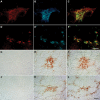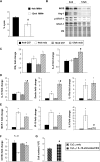Shifts in macrophage phenotypes and macrophage competition for arginine metabolism affect the severity of muscle pathology in muscular dystrophy
- PMID: 18996917
- PMCID: PMC2638796
- DOI: 10.1093/hmg/ddn376
Shifts in macrophage phenotypes and macrophage competition for arginine metabolism affect the severity of muscle pathology in muscular dystrophy
Abstract
Duchenne muscular dystrophy (DMD) is the most common, lethal, muscle-wasting disease of childhood. Previous investigations have shown that muscle macrophages may play an important role in promoting the pathology in the mdx mouse model of DMD. In the present study, we investigate the mechanism through which macrophages promote mdx dystrophy and assess whether the phenotype of the macrophages changes between the stage of peak muscle necrosis (4 weeks of age) and muscle regeneration (12 weeks). We find that 4-week-old mdx muscles contain a population of pro-inflammatory, classically activated M1 macrophages that lyse muscle in vitro by NO-mediated mechanisms. Genetic ablation of the iNOS gene in mdx mice also significantly reduces muscle membrane lysis in 4-week-old mdx mice in vivo. However, 4-week mdx muscles also contain a population of alternatively activated, M2a macrophages that express arginase. In vitro assays show that M2a macrophages reduce lysis of muscle cells by M1 macrophages through the competition of arginase in M2a cells with iNOS in M1 cells for their common, enzymatic substrate, arginine. During the transition from the acute peak of mdx pathology to the regenerative stage, expression of IL-4 and IL-10 increases, either of which can deactivate the M1 phenotype and promote activation of a CD163+, M2c phenotype that can increase tissue repair. Our findings further show that IL-10 stimulation of macrophages activates their ability to promote satellite cell proliferation. Deactivation of the M1 phenotype is also associated with a reduced expression of iNOS, IL-6, MCP-1 and IP-10. Thus, these results show that distinct subpopulations of macrophages can promote muscle injury or repair in muscular dystrophy, and that therapeutic interventions that affect the balance between M1 and M2 macrophage populations may influence the course of muscular dystrophy.
Figures







Similar articles
-
Interleukin-10 reduces the pathology of mdx muscular dystrophy by deactivating M1 macrophages and modulating macrophage phenotype.Hum Mol Genet. 2011 Feb 15;20(4):790-805. doi: 10.1093/hmg/ddq523. Epub 2010 Nov 30. Hum Mol Genet. 2011. PMID: 21118895 Free PMC article.
-
IFN-γ promotes muscle damage in the mdx mouse model of Duchenne muscular dystrophy by suppressing M2 macrophage activation and inhibiting muscle cell proliferation.J Immunol. 2011 Nov 15;187(10):5419-28. doi: 10.4049/jimmunol.1101267. Epub 2011 Oct 17. J Immunol. 2011. PMID: 22013114 Free PMC article.
-
Arginine metabolism by macrophages promotes cardiac and muscle fibrosis in mdx muscular dystrophy.PLoS One. 2010 May 21;5(5):e10763. doi: 10.1371/journal.pone.0010763. PLoS One. 2010. PMID: 20505827 Free PMC article.
-
Regulatory interactions between muscle and the immune system during muscle regeneration.Am J Physiol Regul Integr Comp Physiol. 2010 May;298(5):R1173-87. doi: 10.1152/ajpregu.00735.2009. Epub 2010 Mar 10. Am J Physiol Regul Integr Comp Physiol. 2010. PMID: 20219869 Free PMC article. Review.
-
Regulatory T cells and skeletal muscle regeneration.FEBS J. 2017 Feb;284(4):517-524. doi: 10.1111/febs.13827. Epub 2016 Aug 18. FEBS J. 2017. PMID: 27479876 Review.
Cited by
-
Defective dystrophic thymus determines degenerative changes in skeletal muscle.Nat Commun. 2021 Apr 8;12(1):2099. doi: 10.1038/s41467-021-22305-x. Nat Commun. 2021. PMID: 33833239 Free PMC article.
-
Rutin pretreatment promotes microglial M1 to M2 phenotype polarization.Neural Regen Res. 2021 Dec;16(12):2499-2504. doi: 10.4103/1673-5374.313050. Neural Regen Res. 2021. PMID: 33907040 Free PMC article.
-
IL-6 signaling blockade increases inflammation but does not affect muscle function in the mdx mouse.BMC Musculoskelet Disord. 2012 Jun 20;13:106. doi: 10.1186/1471-2474-13-106. BMC Musculoskelet Disord. 2012. PMID: 22716658 Free PMC article.
-
The multifaceted role of macrophages in homeostatic and injured skeletal muscle.Front Immunol. 2023 Oct 25;14:1274816. doi: 10.3389/fimmu.2023.1274816. eCollection 2023. Front Immunol. 2023. PMID: 37954602 Free PMC article. Review.
-
CCR2 deficiency does not provide sustained improvement of muscular dystrophy in mdx5cv mice.FASEB J. 2017 Jan;31(1):35-46. doi: 10.1096/fj.201600619R. Epub 2016 Sep 21. FASEB J. 2017. PMID: 27655900 Free PMC article.
References
-
- Hoffman E.P., Brown R.H., Jr, Kunkel L.M. Dystrophin: the protein product of the Duchenne muscular dystrophy locus. Cell. 1987;51:919–928. - PubMed
-
- Tidball J.G., Wehling-Henricks M. Evolving therapeutic strategies for Duchenne muscular dystrophy: targeting downstream events. Pediatr. Res. 2004;56:831–841. - PubMed
-
- Hodgetts S., Radley H., Davies M., Grounds M.D. Reduced necrosis of dystrophic muscle by depletion of host neutrophils, or blocking TNFalpha function with Etanercept in mdx mice. Neuromuscul. Disord. 2006;16:591–602. - PubMed
Publication types
MeSH terms
Substances
Grants and funding
LinkOut - more resources
Full Text Sources
Other Literature Sources
Molecular Biology Databases
Research Materials
Miscellaneous

